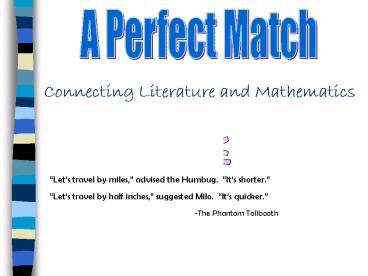Connecting Literature and Mathematics - PowerPoint PPT Presentation
1 / 21
Title:
Connecting Literature and Mathematics
Description:
The combination of mathematics and literature allows children to discover ... Math involves a lot of messing around; sometimes there are multiple solutions or ... – PowerPoint PPT presentation
Number of Views:497
Avg rating:3.0/5.0
Title: Connecting Literature and Mathematics
1
A Perfect Match
Connecting Literature and Mathematics
Lets travel by miles, advised the Humbug.
Its shorter. Lets travel by half inches,
suggested Milo. Its quicker.
-The Phantom Tollbooth
2
Literature gives math meaning.
- The combination of mathematics and
literature allows children to discover
mathematical concepts in a meaningful context.
Math learning becomes more personal.
- Stories present mathematical investigations
which are interesting, exciting, and motivating
to students.
3
Define order in the world Classify Solve
problems Discover relationships Create patterns
?
?
?
?
?
?
?
?
?
?
4
Myth Truth
Math is something you do in a math book.
Math is a way of thinking about the world.
5
Myth Truth
Math is not a part of anything else.
Math is an integral part of living.
6
Myth Truth
Math is looking down at your paper.
Math is a vehicle for looking up and looking out
at our world.
7
Myth Truth
Math always involves using your pencil.
Math involves sharing stories and discussing
ideas.
8
Myth Truth
Math only involves numbers.
Math involves reasoning, communicating,
measuring, and thinking geometrically.
9
Myth Truth
Math is answering questions very quickly.
Math is mulling over ideas and making personal
connections.
10
Myth Truth
Math is the teacher standing at the board.
Math is the teacher working as a collaborative
learner.
11
Myth Truth
Math is not something you should enjoy.
Math is intrinsically rewarding.
12
Myth Truth
Math is turning pages and completing a long list
of problems
Math is turning out our own stories and posing
our own problems.
13
Myth Truth
Math doesnt involve any guessing it is about
getting the right answers.
Math involves a lot of messing around sometimes
there are multiple solutions or no solution at
all.
14
Could you have tea for two without the two or
three blind mice without the three? Would there
be four corners of the earth if there werent
four? And how could you sail the seven seas
without a seven?
-The Phantom Tollbooth
15
Time to read
Time to talk
Time to share
Time to do
16
- Suggestions for using literature
- Read a story uninterrupted.
- Read a story several times.
- Ask broad questions about the story.
- Respond to the stories through activities.
17
Marilyn Burns Reasons To Connect
Childrens literature provides a meaningful
context for mathematics.
Childrens literature celebrates mathematics as a
language.
Childrens literature demonstrates that
mathematics develops out of human experience.
Childrens literature addresses humanistic,
affective elements of mathematics.
Childrens literature integrates mathematics into
other curriculum areas.
Childrens literature restores an aesthetic
dimension to mathematical learning.
18
And Most Importantly.
Childrens literature fosters the development of
number sense.
Childrens literature supports the art of problem
posing.
19
Sample Lesson Structure
Read the story. Share ideas. Discuss
problems. Read the story. Begin an
activity. Process the activity. Read the story.
20
If a small car carrying three people at thirty
miles an hour for ten minutes along a road five
miles long at 1135 in the morning starts at the
same time as three people who have been traveling
in a little automobile at twenty miles an hour
for fifteen minutes on another road exactly twice
as long as one half the distance of the other,
while a dog, a bug, and a boy travel an equal
distance in the same time or the same distance in
an equal time along a third road in mid-October,
then which one arrives first and which is the
best way to go?
-The Phantom
Tollbooth
21
Myths and truths from Its the Story That Counts,
by Marilyn Burns.































